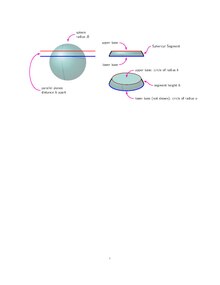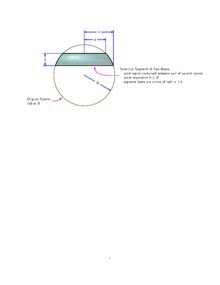Spherical segment
This article includes a list of references, related reading, or external links, but its sources remain unclear because it lacks inline citations. (May 2024) |


In geometry, a spherical segment is the solid defined by cutting a sphere or a ball with a pair of parallel planes. It can be thought of as a spherical cap with the top truncated, and so it corresponds to a spherical frustum.
The surface of the spherical segment (excluding the bases) is called spherical zone.

If the radius of the sphere is called R, the radii of the spherical segment bases are a and b, and the height of the segment (the distance from one parallel plane to the other) called h, then the volume of the spherical segment is
For the special case of the top plane being tangent to the sphere, we have and the solid reduces to a spherical cap.[1]
The equation above for volume of the spherical segment can be arranged to
Thus, the segment volume equals the sum of three volumes: two right circular cylinders one of radius a and the second of radius b (both of height ) and a sphere of radius .
The curved surface area of the spherical zone—which excludes the top and bottom bases—is given by
See also[edit]
References[edit]
- Kern, William F.; Bland, James R. (1938). Solid Mensuration with Proofs. p. 95–97.
External links[edit]
- Weisstein, Eric W. "Spherical segment". MathWorld.
- Weisstein, Eric W. "Spherical zone". MathWorld.
- Summary of spherical formulas
- ^ Kern, Willis; Bland, James (1938). Solid Mensuration with Proofs (Second ed.). New York: John Wiley & Sons, Inc. pp. 97–103. Retrieved 16 May 2024.



![{\displaystyle V={\biggl [}\pi a^{2}\left({\frac {h}{2}}{\biggr )}\right]+{\biggl [}\pi b^{2}\left({\frac {h}{2}}{\biggr )}\right]+{\biggl [}{\frac {4}{3}}\pi \left({\frac {h}{2}}\right)^{3}{\biggr ]}}](https://wikimedia.org/api/rest_v1/media/math/render/svg/d7471ad7473b6909c362fb97c9fd839ac4d0f7b1)

